Recent Posts
-
And Yet, We Go On
April 22, 2024
-
It IS Happening Here
February 16, 2024
-
General Ludd to General Intellect
January 11, 2024
-
Temporal and Geographic Edges
December 26, 2023
-
The Root of All Evil
October 13, 2023
-
Post-Pandemic Melancholia . . . Same As It Ever Was?
September 3, 2023
-
Chronicle of Deaths Foretold
June 24, 2023
-
Reparations is the Least We Should Do
May 11, 2023
-
We Are Not Alone
April 9, 2023
-
War and Anti-War
February 22, 2023
|
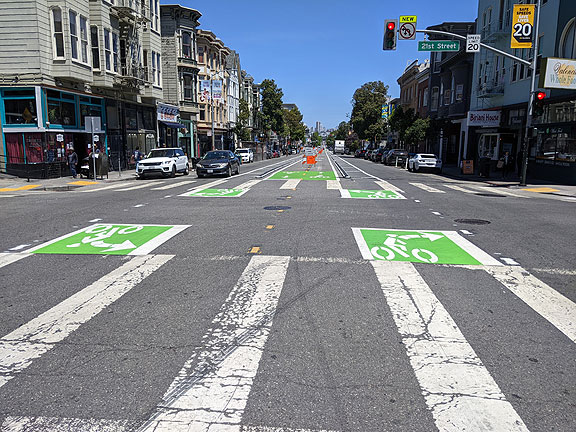 The disastrous new center bike lane on Valencia Street. San Francisco street engineers have begun implementing what the world’s best-known bicycling diplomat, Copenhagenize’s Mikael Colville-Anderson, called the “worst infrastructure I have ever seen anywhere in the world.” The new center-of-the-street two-way cycle path on Valencia from 23rd to 15th is a disaster. It was only supported by 18% of cyclists in surveys conducted by the SFMTA months ago, and was objected to by well over 70% of respondents.
I’ve been out there riding on it a half dozen times already, even though it’s officially closed. Hundreds of other cyclists have been doing the same since the old bike lanes have been removed. As the Mission Local article documented, there’s already been a number of accidents, and at least a couple of cyclists have been hospitalized after trying to leave or enter the absurd center lanes.
So why are they doing this? Why move the once hugely popular Valencia bike lanes from the sides to the center when an overwhelming number of local cyclists opposed it? Who benefits from this? How many more will be hurt or killed before they undo this?
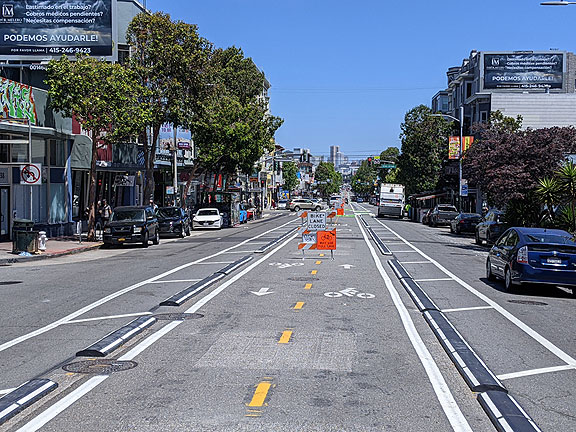 Another view with the rubber “protective” pieces installed. Soft posts to come. It’s true that the bike lanes along the sides have been largely wrecked by endless double-parking, especially though not exclusively by Uber and Lyft drivers. It’s been incredibly irritating that the out-of-town clueless rideshare drivers have been allowed to stop wherever they want, wherever someone clutching a cell phone randomly called for a ride. How difficult would it have been for the city to create organized drop-off and pick-up spaces near the corners of each block to accommodate this?
During the last few years before the pandemic, Valencia Street had become an awful street to bicycle on. Double parking, random U-turns anywhere and anytime, cars weaving in and out of the bike lanes while drivers stared at their phones, and so on. I can only imagine this all becoming worse with the new center lanes. Cars will ignore the low rubber separators but bicycles will have a hard time leaving the center lane mid-block. In fact, bicycles will have a hard time leaving the center lane anywhere! Because the ridiculous diagonal entry and exits at 23rd (and 15th eventually) are completely unfamiliar to everyone. Neither cyclists nor motorists will know how to behave or what to expect and it’s a certainty that there will be a great number of needless collisions when drivers and cyclists take their right of way at the same time.
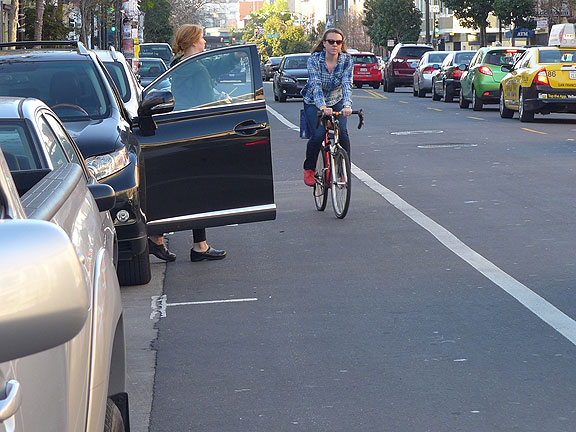 The original configuration, seen here in 2015. Dooring always a possibility.
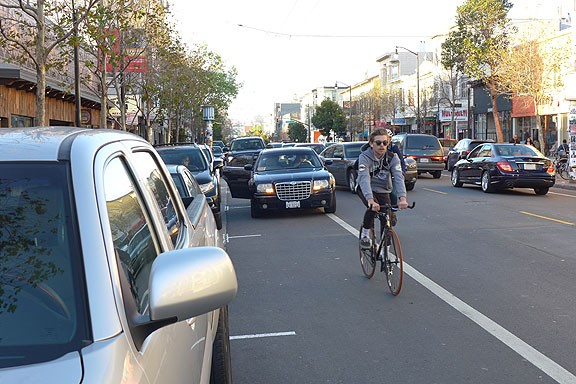 This was a typical weekday in 2015 with endless double parking of cars forcing cyclists in and out of the bike lane. For all the merchants used to having cyclists pull up to their establishments with ease, they will now see most people opt to pass them by because of the inconvenience of stopping once you enter the center lane. I’m glad to see former metered parking eliminated in favor of loading zones and 5-minute limit pickup and dropoff zones as part of the street reconfiguration. Finally. But taken together, restricted parking and difficult access for cyclists, it may lead to worse business conditions along the once thriving corridor.
Motorists are sure to complain loudly about the restricted parking on Valencia, but the reality is that San Francisco is overflowing with parking. In Henry Grabar’s very informative and entertaining new book Paved Paradise: How Parking Explains the World, he details the remarkable numbers. “By square footage, there is more housing for each car in the United States than there is housing for each person.” In San Francisco there are 441,541 curb spaces, more than one for every household. In the Bay Area, there are 15 million parking spots, 2.4 for each car.
But overall, the reconfigured Valencia Street is an obvious failure before it’s even fully implemented. Turns out, beyond the specifics of this odd design, the issues have been with us much longer. Back in the 1890s about one in five San Franciscans were regular bicyclists, a higher rate than today’s. And just like today, the mainstream advocates of cycling were endlessly frustrated with the so-called misbehavior of some cyclists:
At a conference on municipal improvements in 1897, one speaker declared that “the greatest enemy to the cyclist in moulding public opinion, is the scorcher, whose sins are visited on all wheelmen, and they are held responsible for his misdemeanors. . .” Their actions, at least theoretically, threatened to endanger the reputation of cyclists as a whole.
p. 53, The Cycling City: Bicycles and Urban America in the 1890s by Evan Friss, University of Chicago Press: 2015
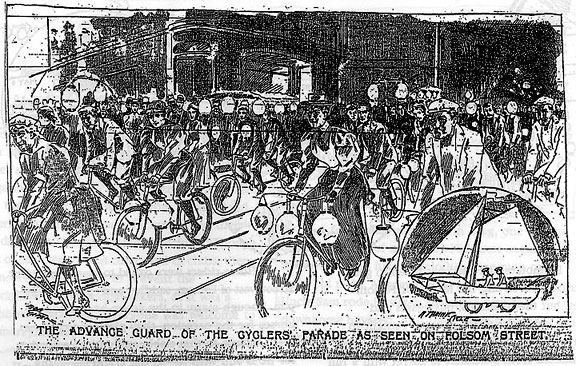 Image of “Good Roads” demonstration by bicyclists in San Francisco, 1896. Complaints about the lack of perfect personal behavior on the part of cyclists wouldn’t be so bad if it didn’t perpetually fuel the bizarre animosity non-cyclists direct to bicyclists. In Jody Rosen’s entertaining Two Wheels Good: The History and Mystery of the Bicycle, he cites a study that concluded that 49 percent of non-cyclists regard cyclists as “less than fully human.” As someone who has been cycling in San Francisco and many other world cities over the past four decades, I can confirm that this is indeed the attitude of all too many people behind the wheel of their cars. But anytime a cyclist has tried to say this, either in opinion columns or in the comments section of numerous online publications, they are soon swamped by the angry retorts of motorists or elderly pedestrians who are sure that cyclists are the real criminals on the road. But it’s the transportation system, distorted to emphasize private automobiles by decades of lobbying and outright manipulation of government subsidies, that is the source of the problem. We won’t fix it by tinkering along the edges of various streets, as long as we continue to put the car at the center of everything. John Stehlin in his brilliant book Cyclescapes of the Unequal City: Bicycle Infrastructure and Uneven Development (University of Minnesota Press: 2019), says it well:
At issue is that the collective consumption of the street is mediated through vehicles. While there is a tendency to view mass transit as “public” and automobility as “private,” vast public subsidies go into the making of streets with specific affordance that prioritize automobiles. (p. 89)
Continue reading Chronicle of Deaths Foretold
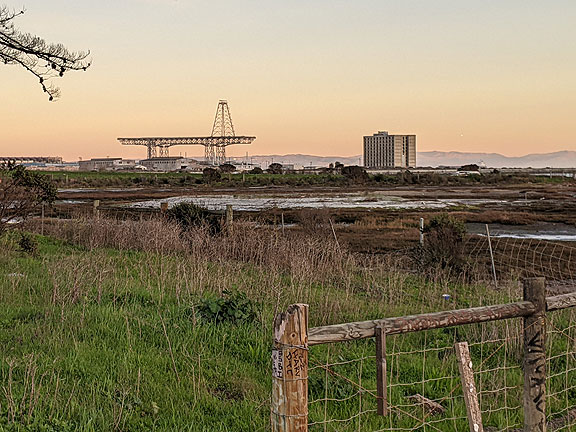 Easterly view over Parcel E of the former Hunters Point shipyards, probably the most radioactive and toxic site in any city in the U.S. I’ve been following the State of California’s slow-moving effort to determine whether or not it should take responsibility for providing reparations for African Americans for historic crimes and systematic racism. The official body in charge of this process is already furiously pedaling backwards as the right-wing echo chamber amplifies false exaggerations that every black Californian is going to be eligible for a $1.2 million payout from the state. If only!
I support paying reparations to folks whose ancestors were held in slavery. I also support paying reparations to people whose families have persisted through a further century of Jim Crow racism, redlining and restrictive covenants, systematic disinvestment, and myriad forms of exploitation both obvious and subtle. California has a deeply racist history that is sometimes overlooked in the present era of self-congratulatory “Blue State” liberal hegemony. If not overlooked, the deep structural and social racism that shapes life in California to this day is downplayed in favor of the Obama-ish invocation of progress and earnest intentions to do better. But any unblinkered examination of California’s history, including the Bay Area and certainly including San Francisco itself, quickly comes face to face with legacies of blatant racism that clearly still influence much of our daily lives.
A while ago I read Eugenic Nation: Faults & Frontiers of Better Breeding in Modern America, by Alexandra Minna Stern (University of California, 2nd edition, 2016), which is an excellent survey of how deeply eugenicist politics influenced assumptions underlying public health, national borders and immigration, education, and more. How many people know that at the 1915 Panama-Pacific International Exposition in San Francisco an organization called the “Race Betterment Association” had a prominent booth, and held a convention that brought to San Francisco prominent racist and eugenicist figures from around the state? Or that the ideas of “race betterment” that were honed by this association and a couple of others were embraced by the Nazi government in Germany by 1934, where they were partly inspired by official California sterilization policies to begin their own racial purity campaigns?
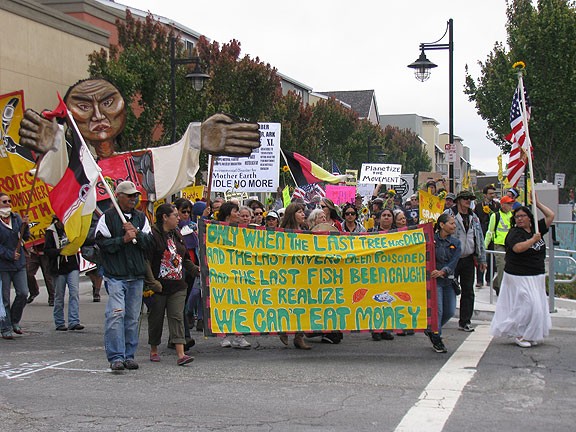 Protesters in 2013 in Richmond march on Chevron, pointing out the obvious: you can’t eat money! The progressive Bay Area is very proud of its incredible history of environmental resistance to the depredations of untrammeled modernism and the imperatives of speculative capital. But few realize that the men who launched the Save the Redwoods League at the beginning of the 20th century were prominent eugenicists. As Stern argues, “Saving the redwoods meant more than just protecting a tree; it was a metaphor for defending race purity and ensuring the survival of white America … Nonetheless, the alliance between eugenic racism and environmentalism, which seemed quite natural to the founders of both movements, continues to flicker on and off in the twenty-first century in the xenophobic platforms endorsed by the population section of the Sierra Club, and sometimes in the rhetoric employed to campaign for greenbelts, no- or slow-growth polices, and strict zoning codes.” (p. 148, 151)
Eugenics was widely discredited by the holocaust and Nazi concentration camps, but its ideas had by then been “naturalized into federal, state, and even municipal institutions and were underpinning postwar norms of conformity.” (p. 177) It wasn’t until the 1940s that anti-miscegenation laws were repealed in California, but by then an entire generation of Filipino men, to cite one example, had lived without the ability to bring over spouses or families from the Philippines, nor were they officially allowed to marry women of other races. Sundown towns were known throughout California—San Leandro for example enforced its border with Oakland quite vigorously well into the late 20th century.
In another book I read a couple of weeks ago, The Bonds of Inequality: Debt and the Making of the American City, Destin Jenkins brilliantly dissects the profoundly racist operation of the municipal bond market in San Francisco dating back to the immediate post-WWII period. Bond merchants and banks, where their obscure offices were tucked, had been thoroughly exposed as incompetent and (often) corrupt by the Great Depression. New Deal banking reforms, ironically, gave those very same bond sellers and banks a new lease on life by giving them control of a strategically vital lever of power in any urban area: the spigot of capital for infrastructure investment. Determined to resuscitate and “save” capitalism, New Deal banking reforms didn’t just overcome the Depression (albeit with a big boost from military spending during WWII that continued ever since). As Jenkins convincingly argues, “For near thirty years, federal guarantees for bondholders did more than provide commercial banks with liquidity, profits, and dividends for shareholders: the federal government helped unlock banker prosperity.” (p. 191)
By the 1970s, rising inflation and unemployment as deindustrialization swept away large parts of U.S. manufacturing led to the fiscal crisis of the state. Municipal bond markets by then had sustained decades of tax-dodging profitability. The bond market is a system where the wealthy could purchase federally tax-exempt bonds (and avoid paying the prevailing high tax rates), while enjoying rigid guarantees that their investments and the interest they charged municipalities (as the price for providing funds for schools, parks, sewage and water systems, roads and freeways, etc.), would be paid back ahead of all other priorities in city finances. Our contemporary crisis of crumbling infrastructure can be traced directly to this self-defeating arrangement of depending on the rich for debt financing, rather than a robust system of taxation that would actually be subject to some version of democratic controls. As Jenkins says, “It was in the crucible of high interest rates and dependence on lenders that the deterioration of urban infrastructure accelerated.”
More importantly, Jenkins has framed his exposé in terms of the underlying racism that shaped San Francisco and U.S. cities more broadly.
During a moment of historically low interest rates [in the 1940s and 50s], black neighborhoods were continuously deemed unworthy of debt. The twenty-year moment when money was cheap is marked by what I call the infrastructural investment in whiteness. (p. 15) … Infrastructure was … not only a means of achieving economic growth by accommodating the white consumer, tourist, and executive; it also symbolized an investment in middle-class whiteness per se. From public parks and museums to roads and parking garages, infrastructure was an expression of white rights, of the expectation of an expansive public. Offering a San Francisco twist to the Keynesian city, streets, parks, and museums were repurposed in service of “state-backed, debt-financed consumption.” Just as federally guaranteed mortgages propelled white middle-class suburbanization, municipal debt made possible the well-paved streets, downtown parking garages, new sports arenas, and rehabilitated art spaces for the white middle- and upper-class urbanite. White construction workers in segregated building trades enjoyed the spoils by literally building the consumer playground and upgrading crumbling cultural landmarks. (p. 69-70) … San Francisco’s infrastructural investment in middle-class whiteness was grounded in its working-class companion, the segregated building trades… In San Francisco during the 1950s and early 1960s, skilled construction jobs were for white men, and the city’s building trade unions worked to keep it that way. (p. 79)
When the U.S. Supreme Court outlawed racially restrictive covenants on neighborhood residency in 1948, for the first time middle-class residents of Chinese and Japanese descent began moving into the Sunset and the Richmond districts. Black families who could afford to were able to buy properties in the Outer Mission/Ingleside area in the southwest. And public housing projects under the management of the San Francisco Housing Authority (SFHA) was required to desegregate too; finally the previously all-white Valencia Gardens at Valencia and 15th opened up to Latinos, Asians and African Americans. This story is somewhat well known, at least to those who have looked into it. Less well understood is that the SF Housing Authority depended on its own version of municipal bonds to operate public housing projects. By 1958 the SFHA had become the City’s largest landlord with 4250 units in fourteen permanent projects. Jenkins is at his best in explaining what this relationship meant for the evolution of public housing here:
Through debt, the San Francisco Housing Authority came to house poor residents while providing safe investment outlets for bondholders. (p. 109) By locating public housing in redlined areas and issuing tax-exempt, federally guaranteed debt, the SFHA inadvertently monetized the city’s most devalued lands in new ways. Suddenly, redlined neighborhoods, once defined by racial threats, slum dwellings, and “unpleasant odors” from nearby stockyards and packing plants, were outlets for institutional capital. (p. 95) … Rather than fund the construction, upkeep, maintenance, and beautification of crumbling housing projects, bankers used the absence of interest rate restrictions on short-term public-housing debt to capture income. While public housing authorities were bled dry, Bank of America increased its holdings of Public Housing Authority notes from $165 to $270 million between December 31, 1964 and September 15, 1965. (p. 99) [emphasis added] … The debtor-creditor arrangement did more for the institutional capital than for the tenants who lived in the housing it funded… What made the public-housing arrangement unique was that the layers of guarantees, protections, and hierarchy of claims betrayed in a most glaring way the divergent interests of borrowers and bondmen, tenants and creditors. In a sense, the program became a laboratory for the profitability of poverty and how short-term debt could mollify the cost-profit squeeze of bondmen. (p. 100) … The deterioration of public-housing projects was taken as proof of the failures of socially oriented public policies rather than as a consequence of a structural arrangement that, from the beginning, privileged the claims of bondholders. (p. 109) While maintenance costs [at SFHA projects] rose around 13 percent between 1963 and 1966, rental income rose just 3 percent. The “wanton destruction of buildings” necessitated hiring glaziers to recut and replace broken windows. The SFHA blamed window breakers without entertaining how inflation, dependence on an extractive market, and the prioritization of lenders over tenants also contributed to escalating maintenance costs. (p. 122)
There is a great deal more in Jenkins’ excellent book. He shows how the infamous “structural adjustment” that was imposed on Third World countries like Mexico and Nigeria in the wake of the debt crisis created by profligate lending of recycled petro-dollars (after the 1973-74 “oil crisis”) got its first use on municipalities in the U.S.
Put simply, structural adjustment emerged out of the contingencies of municipal debt and entailed cuts for ordinary people and guaranteed rents and protections for bondholders. In addition, municipal borrowers truncated long-term political horizons. Paying the next bill took precedence over addressing the social crisis of austerity. (p. 218)
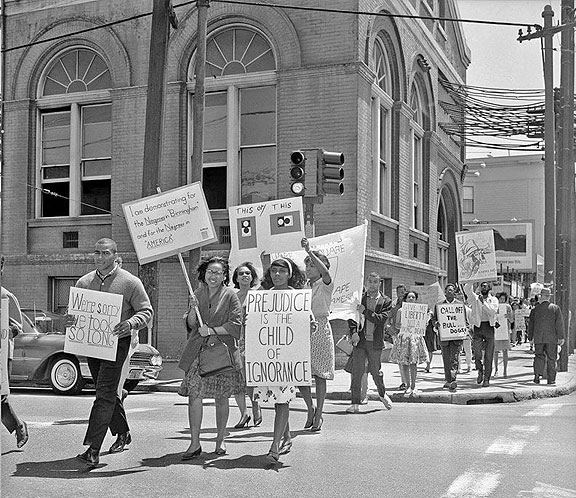 Civil rights protesters at Turk and Fillmore Streets, 1963.
 Police officers threaten protesters during Hunters Point Uprising, September 1966. Continue reading Reparations is the Least We Should Do
I’ve been home for a week with my second bout of COVID. This one came creeping in with Adriana after she returned from a bonspiel (a weekend curling competition/party in Roseville) and after a few days we were both down for the count. Should be ok in another 2-3 days max. I haven’t been blogging for a long time again. When I tried to focus on it, other things kept distracting me. At least my novel is done (for now). I have it at a 2nd publisher after it was rejected by the first, and a friend is working on a TV-series treatment, so we’ll see where we are in a month or two. One of my major goals with the novel was to make nature itself a character. I did this by way of a bioengineered fungus and the unexpected relationships developed in and around it as it proliferates in the San Francisco of the near future. I’m not sure if I pulled it off, but eventually we will see.
 Red-Shouldered Hawk near Lake Merced in 2014. Anyone who knows me knows that I am not a pet person (and definitely NOT a dog person!). I don’t have any animals in my life that I have a direct relationship with that way (though I grew up with cats when I was a child, so I usually have an easy rapport with any cat I come close to even if I’m allergic to them now). On the other hand, I’ve become quite a big “fan” of bird watching and after the most recent rainy trek through Golden Gate Park (on my March 11 birthday) with Josiah Clark, I’ve enjoyed at least four straight years of getting to know the abundant springtime bird life that graces that part of town (around 80+ distinct species!). I’m also an enthusiast for the regular presence of wild coyotes in our local open spaces, the midnight visits from giant raccoons that patrol our backyard, the seals and sea lions that duck under the water as our boat nears them in the bay, and the many charismatic large birds that I encounter whenever I approach the bayshore.
 Redtailed hawk munching a pigeon on Thanksgiving Day 2002 at 19th and Dolores.
 Coyote skirting slopes of Bernal Heights in 2022.
 Here’s a coyote on Corona Heights in 2020 with a woman walking her dog just beneath at the right. …the necessity of communicating impressions, of playing, of chattering, or of simply feeling the proximity of other kindred living beings pervades Nature, and is, as much as any other physiological function, a distinctive feature of life and impressionability.
—Peter Kropotkin, Mutual Aid, 1902 (PM Press: 2021)
The shifting baseline of our expectations is inseparable from the crisis of biodiversity. We grasp for the butterflies, bees, and native plants that were once the dense fabric of local ecology and are now the remaining loose threads. Local efforts to repair “natural areas” have had some success (we’ll be touring some of them by bike on April 23), but we don’t know what it’s like to have the sun disappear behind billions of birds flying overhead for days on end, as the early European visitors did. The radical abundance of elk, bear, salmon, ducks, and so many other species that the first visitors described are now recognized to be an anomalous outcome of the microbial invasion that predated the actual arrival of European colonists.
California was the densest populated area of North America and it was largely without sedentary agriculture. Nevertheless, the landscape was cultivated and managed. The close proximity to dozens of other groups, many speaking radically different languages, led to a California full of mutual tolerance and relatively clear boundaries for gathering acorns, berries, greens, roots, and game. And the dense human population kept the numbers in check for large predators as well as herds of ruminants. When the California Indian population began to succumb to new diseases in the late 1600s and early 1700s, the animal populations began to explode, so that when European colonists arrived the land seemed full of wild life in a way that had probably seldom been the case for centuries.
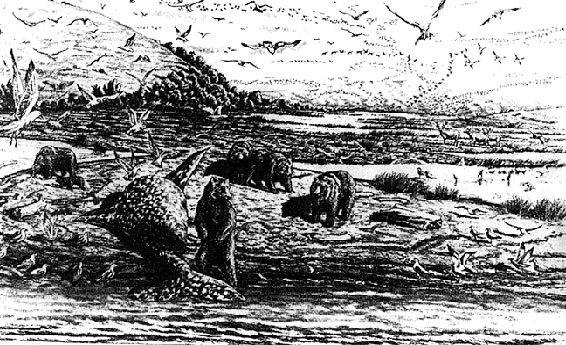 A depiction of what it might have been like at Candlestick Point in pre-colonization times. (image courtesy The Ohlone Way) …the road to [nearby Mission Dolores] was easily recognizable from the heads of bulls and the bones and carcasses of dead horses scattered everywhere; the foul smell from them and the flocks of crows, seagulls, and various hawks devouring all of this carrion usually means the proximity of habitations. I think that this province is indebted solely to the feathered kingdom for protection against infections and epidemic disease.
—Excerpt from Andrey Lazarev’s Journal of a Visit to Alta California 1823-1824 (in California Through Russian Eyes, 1806-1848, Volume 2, compiled, translated, and edited by Janes R. Gibson, The Arthur C. Clark Company, University of Oklahoma Press, Norman OK: 2013)
Continue reading We Are Not Alone
|
|

























